Day 3 of a three day long weekend of Early Winter Tours today, our last day. It was another lovely bright, sunny crisp day with blue skies. There was a fresh breeze from the east, but it was not as cold or as blustery as had been forecast. Another great day to be out on the coast.
With reports of a mixed flock of redpolls in Wells Woods again yesterday, we decided to pop in here briefly first thing. As we walked down towards the boating lake, we heard Redpolls calling and looked up to see five fly off over the pines towards the beach. A good start, but it was marred by meeting another birder leaving who told us he had seen the big flock first thing, but they had flown off and he hadn’t been able to find them for an hour since.
We stopped at the boating lake to see if there was anything on there this morning. A pair of Gadwall on the bank were new for the weekend’s list. Another pair of Gadwall swam out of one of the channels in the reeds the other side, the drake keeping very close to the female, which we could understand when another drake swam out in pursuit. There were a few Little Grebes and a Tufted Duck out on the water too. A Kingfisher called as it flew out from the far bank, but disappeared round the corner before anyone could get onto it.
As we walked on along the main track, we could hear Bullfinches calling, but they were hidden from view, probably down in the brambles somewhere in the reeds. It was clear that more thrushes had arrived overnight. A Fieldfare flew in and landed in the top of a tall poplar, where we got it in the scope. Then a Redwing flew up into the birches behind us, calling. As we continued on, we flushed lots of Blackbirds and several more Redwings from the bushes by the path.

When we were almost level with the edge of the Dell, we heard more Redpolls calling and looked up to see a large flock of 30 or so flying in from the direction of the caravan park. There appeared to be a fairly high proportion of pale birds in the flock – Mealy Redpolls – but they flew straight across the track and disappeared behind the trees, heading in the direction of the Dell.
We walked round and out to the middle of the Dell meadow, flushing a rather pale Common Buzzard from the trees on the sunny edge as we did so. We stopped here for a while and scanned the birches all around, expecting the redpolls to be feeding here, but there was no sign of them. A Siskin flew over calling.
As we walked into the trees, we could hear a Chiffchaff calling, but it promptly went quiet. We had a quick look along the path on the east side of the Dell for the redpolls, then round to the birches by the toilet block to try there. The sun was catching the trees in the open glade here and a Chiffchaff flew across and started flycatching from the tops. We watched it for a while, picking at the undersides of the leaves too, before it was joined in the same tree by a second Chiffchaff. It will be interesting to see if they try to overwinter here, or move on again once the weather turns colder.
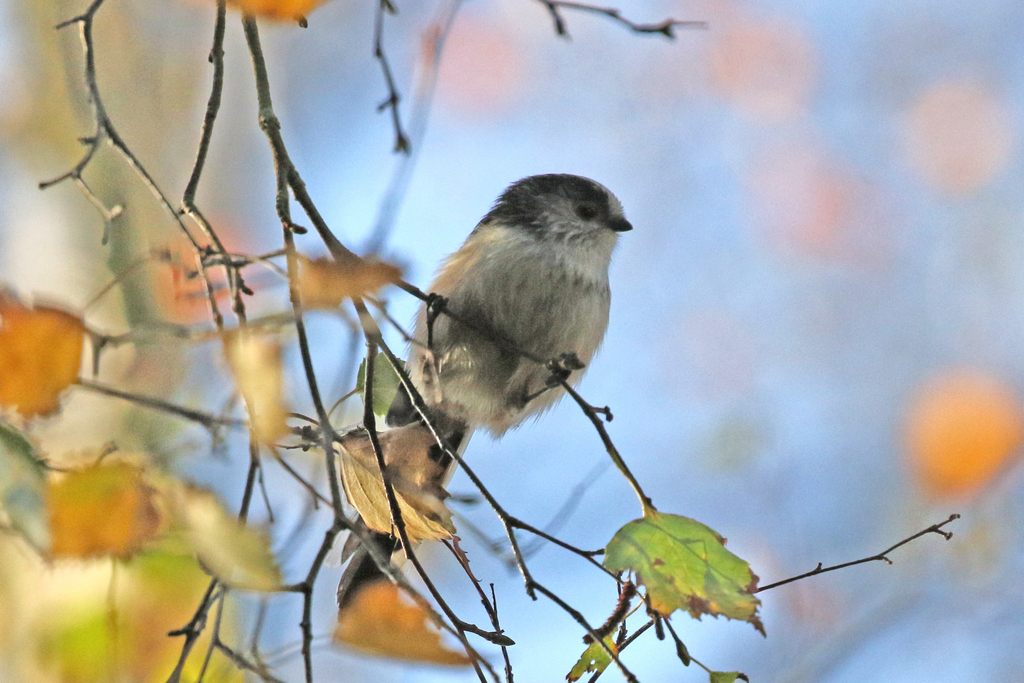
There was no sign of the redpolls anywhere in the birches between there and the boating lake, just a flock of Long-tailed Tits which worked their way quickly through the trees above our heads. We had planned to spend the day further west along the coast today, so we decided to resume plan ‘A’.
On our way west along the coast road, we stopped briefly to admire a large flock of Pink-footed Geese in a field just before Titchwell village. A single Greylag Goose was with them – though it was impossible to tell whether it was an Icelandic bird which had travelled with them or a local one which had just got in with the wrong crowd.
There were lots of people when we got to Thornham Harbour, out walking, making the most of it and taking the air on a sunny Sunday morning. We had a quick look in the harbour channel, but all we could see were a couple of Common Redshanks. There were just a couple more Common Redshanks around the sluice – perhaps it was just too disturbed here today.
As we climbed up onto the seawall, a male Stonechat was perched up on one of the signs by the gate, but it was flushed by walkers and flew down towards the grazing marsh. We found it again perched on a fence post across the grass, together with a female Stonechat. A Meadow Pipit appeared out of the grass below them.
A large flock of Curlew flew in from the direction of Holme, and dropped down towards the saltmarsh. From the corner of the seawall, we could see they had joined another group which were already roosting out there. We counted almost 100, but more Curlews continued to arrive in small groups while we stood and looked out across the harbour. A large group of Teal were roosting in the sunshine along the muddy bank of the channel opposite.
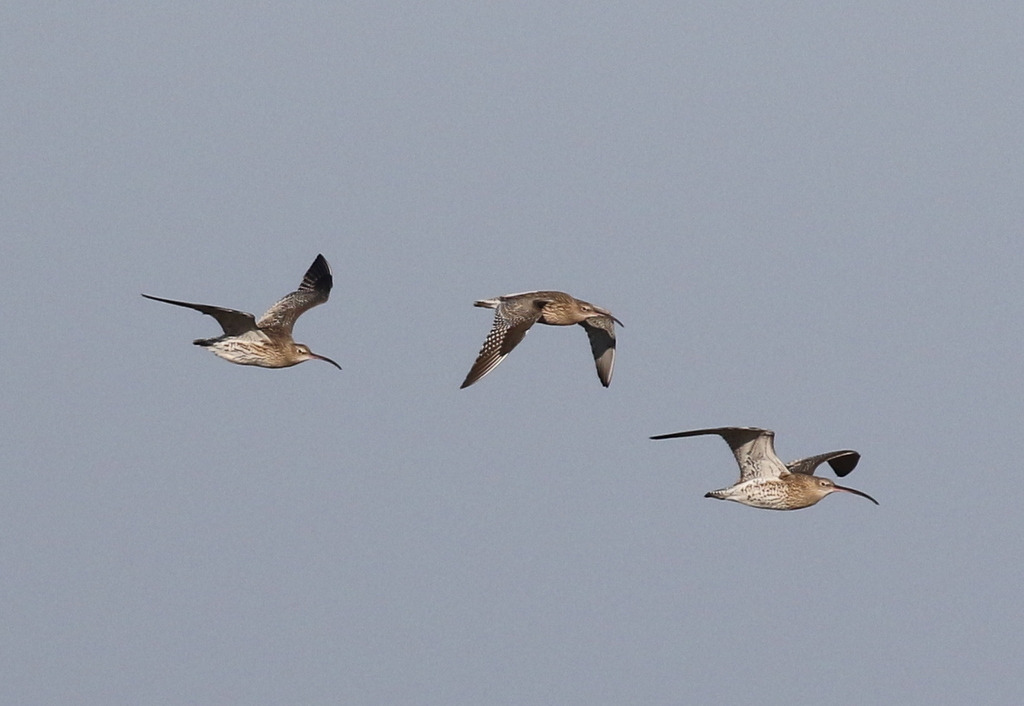
There were a few groups of Linnets and Skylarks flying around the seawall, but nothing seemed to settle with all the people walking back and forth. We decided to walk out to the beach. A quick look at Broadwater as we passed revealed just a few ducks – mainly Mallard and Gadwall but with a pair of Shoveler and some distant Wigeon too – and several Coot.
There were lots of people out on the beach too today, so not many waders on the sand in front of us. There were more looking away to the east, on the sand banks in front of the harbour, principally a large roost of Oystercatchers, though a few silvery grey Sanderling were busy running around on the shoreline nearby. A single Ringed Plover flew past. Something obviously disturbed the Curlews from the saltmarsh because they flew out over the beach and landed here too, joining the Brent Geese and Cormorants drying their wings out on the sand.
The sea was much choppier today. A very distant flock of Eider flying west in front of the wind turbines was hard to see, but thankfully then two flew east just behind the breakers a little later which were much easier for everyone to get onto. There were several small groups of Red-breasted Mergansers on the sea, which we got in the scope, and one or two Great Crested Grebes, but there didn’t appear to be much else out on the water today. A few Gannets and Guillemots flew past.
On the walk back, three Little Grebes had appeared out of the reeds on Broadwater. We were aiming for Titchwell for the afternoon, but we decided to make a short diversion inland on the way there to see if we could find any flocks of farmland birds. All the usual likely fields and hedges were rather quiet – there is still plenty of food available, so the bigger flocks have not really gathered yet. A Sparrowhawk flushed from the hedge and flying down the verge behind us was the highlight.
We stopped for lunch at the picnic tables by the visitor centre. The feeders held a good selection of commoner finches, including one or two Greenfinch which are always nice to see these days. A Coal Tit popped in briefly too.
After lunch, we made our way out onto the reserve. Three Marsh Harriers were circling over the back of the reedbed, but there was nothing on the pool here today. Looking out over the saltmarsh, we could see a Curlew, a Redshank and a Little Egret. Another Curlew and a lone Grey Plover were roosting on the Lavendar Marsh pool.
There were lots of birds out on the Freshmarsh, so we popped into Island Hide to scan through. The first thing we were struck by were the Teal. There were lots of them and several were dabbling on the wet mud right in front of the hide. In the afternoon sunshine, the drakes were looking stunning. There were a few Shelduck here too and a handful of Shoveler. A large mob of Wigeon were feeding over the back, in the enclosure on the fenced off island.
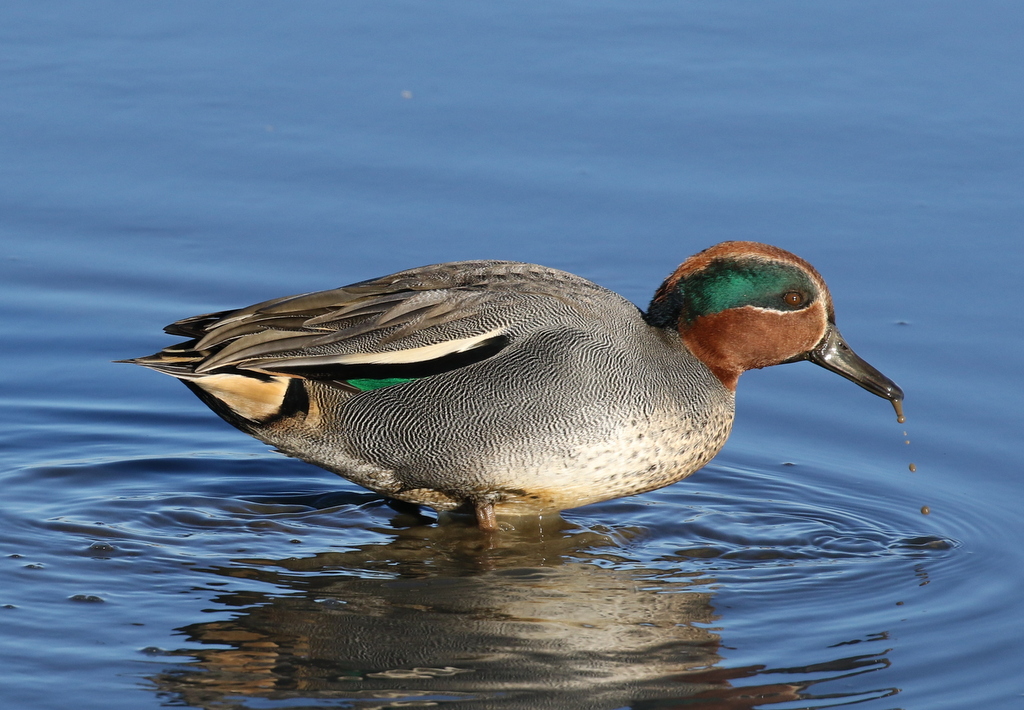
Despite it being just after high tide, there were not as many waders roosting on here as we might have expected. There were a few Black-tailed Godwits, but they were right over in the far corner. Most of the Avocets have left for the winter, but ten are still hanging on here, hoping to be able to avoid the need to move further south. Most of these were also over towards the back, but one Avocet was feeding around the edges of the nearest island.
Four Dunlin were feeding busily on the mud in front of us, and there was another larger flock of Dunlin further over, in front of Parrinder Hide. A single Ringed Plover was with them. The Wigeon were very nervous, and kept irrupting at intervals from the fenced off island, before flying back in to feed. After one such irruption, a Common Snipe appeared from hiding on one of the other islands nearby and promptly went back to sleep on the edge of the vegetation where we could see it.
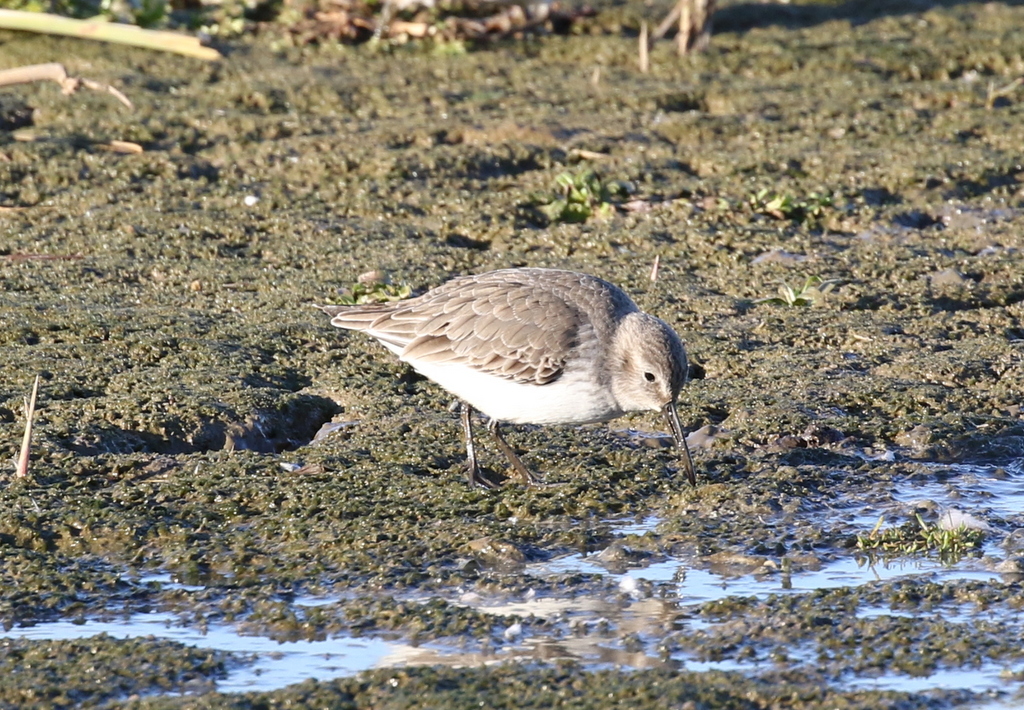
A scan along the edge of the reeds the other side of the hide had failed to reveal the hoped for Water Rail. Then as we were about to leave, one of the group spotted the back end of a Water Rail disappearing into the vegetation. Thankfully, after a few seconds it reappeared and we watched it working its way in and out of the reeds along the edge.

We headed round to Parrinder Hide next. On the way, a small flock of Brent Geese flew in from Thornham saltmarsh and came low right over our heads as they dropped in towards the Freshmarsh, for a bathe and a drink. The first few misjudged the depth of the water, which is quite shallow at the moment, and aborted their first landing attempt, eventually being more successful a bit further back, where the water is deeper.
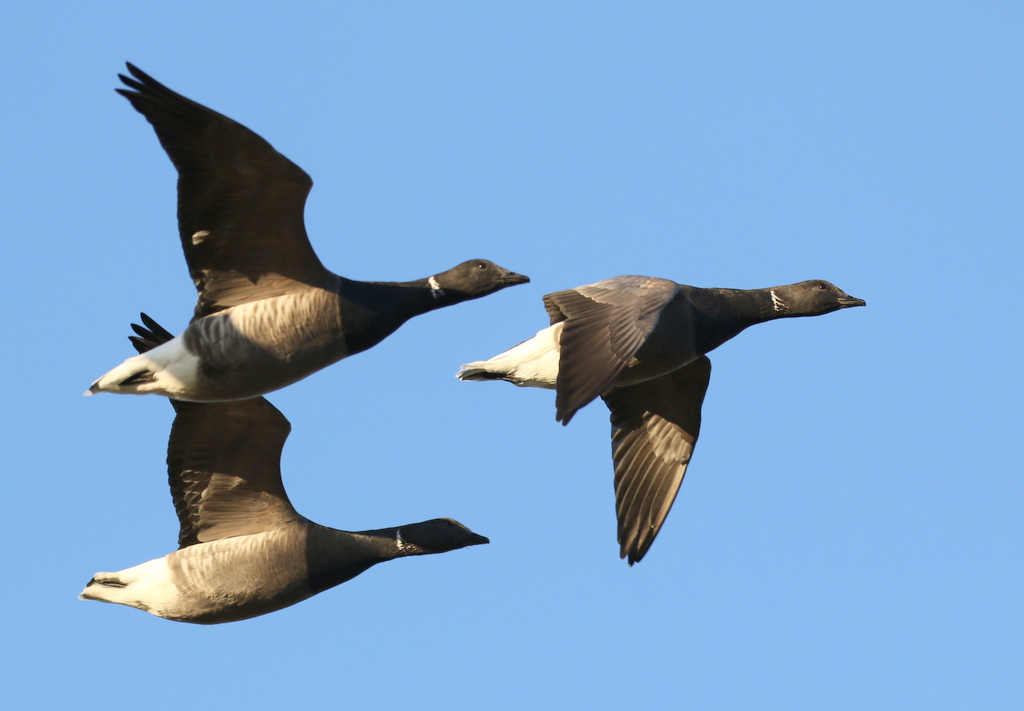
We couldn’t see anything different on the Freshmarsh from Parrinder Hide and there was no sign of the Water Pipit from there this afternoon. One Golden Plover dropped in to the mud in front of the hide, unusually all on its own. We decided to head out towards the beach.
There were a few Common Redshank on Volunteer Marsh and a Little Egret feeding in the channel below the main path. More Redshank were gathered on the tidal channel which stretches back at the far end, along with a few more Black-tailed Godwits and one or two Curlew. We stopped to have a better look at one of the Black-tailed Godwits in the scope.
More waders were roosting out on the one remaining island on the now non-tidal ‘Tidal Pools’, where the water level is now very high again. There were mostly Oystercatchers and Grey Plovers, along with a few Common Redshank. Two paler waders asleep on the front edge of the island were two Greenshank – through the scope we could see their green legs.
Out at the beach, the tide was in. Scattered along the shoreline to the west were lots of Oystercatchers and gulls, and running around in between them were several Sanderling and Turnstones. It was quite choppy now, looking out to sea, and hard to see anything on the water, so we decided to escape the chilly breeze and head back.
As we passed the Tidal Pools, we heard a Spotted Redshank calling. It was obviously on the move, and seemed to have gone over the bank towards the Volunteer Marsh. But as we looked across to all the waders roosting on the island, we could see two slightly paler birds standing next to a Common Redshank. Through the scope, despite the fact that they were asleep, we could see they were two Spotted Redshanks, noticeably more silvery grey above, more obviously spotted with white on the wings. Looking through the Grey Plover from here, we found a single Knot roosting in with them too. A smart drake Pintail was swimming round in front of the island now as well.
We had expected to find the other Spotted Redshank feeding on the Volunteer Marsh, but when we got over the bank we could still hear it calling over towards the Freshmarsh. When we got to the junction with the path to Parrinder Hide, we looked across and found it on the edge of a group of Black-headed Gulls. We had a look at it through the scope and could see its distinctive bill, longer and finer than a Common Redshanks. It was still calling constantly, possibly trying to entice the other Spotted Redshanks in from the Tidal Pools.
By the time we got into Parrinder Hide, it had flown again. Following the calls, it had disappeared round the back of the fenced-off island, out of view. Other birds were starting to gather, and there were more Golden Plover on the Freshmarsh now. More and more gulls were arriving too, and looking through them we found a single Yellow-legged Gull in with the Herring Gulls and Lesser Black-backed Gulls.

It was starting to get dark, so we closed up all the windows in the hide and started to walk back. We could already see several Marsh Harriers circling over the reedbed, and we watched as one after another, six more drifted in high from the west, over the Thornham saltmarsh, dropping slowly over the path and down towards the reeds, getting ready to roost. There were Little Egrets coming in to roost too, one at a time, in over the saltmarsh.
We had enjoyed an exciting three day’s of birding on the coast, and it was now time for us to head for home too. There were still a couple of late surprises in store though. As we drove back east along the coast road, we spotted a Little Owl perched on the roof of a barn by the road. A little further on a Woodcock flew across the road in front of us, silhouetted against the last of the evening’s light as it flew up and over the hedge. They were coming out for the night, just as we were calling it a day.
















